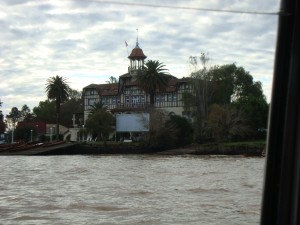The last few days in Buenos Aires have been incredibly exciting. As we begin to settle in, it seems like there is always something new to discover in the city. Today we took bus to San Telmo to see the Zanjon de Granados and the Casa Minima. The Zanjon de Grandos is a museum that is based on the reconstruction of an 1830s house. Zanjon, which means creek, is located where some historians place the first settlement of Buenos Aires. The house was initially bought to be turned into a restaurant, but the owner discovered that there was much more to his new purchase than he anticipated. He stumbled upon underground tunnels which were believed to be part of colonial water systems. The tunnels linked various neighboring houses together. By stumbling upon this hidden aspect of the land, a lot was learned about the history of Buenos Aires. It was interesting to think about if the owner didn’t find the tunnels. That would mean a lot of history of the city would never have been uncovered. Zanjon used to be under a creek that ran in the tunnels. When the owner of the house decided on restoring his purchase, it became a beautiful house. It was a home for the wealthy. One key part of that was that the house had its own water system. It would drain rain water and it would be held in a big storage unit. Inside the unit there were turtles that would keep the water clean from algae. Another interesting part of the house was that it was still under the process of restoration. It’s possible that by continuing to restore the area, even more history can be uncovered. The museum is owned and funded by one man, and he is who led the restoration. He is still alive today.
The second part of the tour was of the Casa Minima, which translates to small house. This was across the street from the Zanjon de Granados. Casa Minima was the narrowest house in Buenos Aires. It was considered a slave house. It’s connected to a large mansion and once slavery was abolished the freed slaves moved to this narrow home. This was to keep the former slaves close. The home is one bedroom and still has the original door attached to it.
Both the Zanjon de Grandos and Casa Minima were historically rich and were cool to see. Buenos Aires is a city that was influenced by various cultures and that was definitely seen today.
After enjoying a lunch at Cafe San Juan la Cantina, our group walked around in Puerto Madero. This port is one of three ports in Buenos Aires. We strolled the area and saw various statues and fountains. We had some free time to wander around a bird reservation park. It was by lake and had various birds. There was one tree filled with parrots! Among the trees you can see the skyline from where we have previously walked through (Puerto Madero). It was cool to see the contrasting environments. This was the last thing we did as a group, besides walk and take the bus back to the hotel.
Today was a really exciting day and although there was a lot of walking and some rain involved, the knowledge and experience was worth it!
Basement of Zanjon.
One of three outdoor sections of Zanjon
Tunnels of Zanjon
Casa Minima










